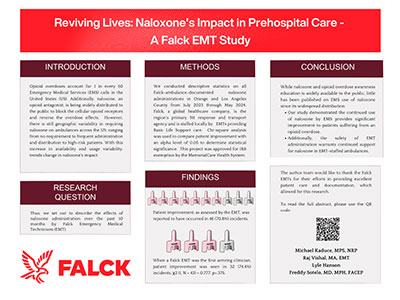ABSTRACTS
Reviving Lives: Naloxone's Impact in Prehospital Care - A Falck EMT StudyAuthor: Michael Kaduce | | Associate Authors: Raj Vishal MA EMT, Lyle Hanson, Freddy Sotelo MD MPH FACEP
Introduction: Opioid overdoses account for 1 in every 50 Emergency Medical Services (EMS) calls in the United States (US). Additionally, naloxone, an opioid antagonist, is being widely distributed to the public to block the cellular opioid receptors and reverse the overdose effects. However, there is still geographic variability in requiring naloxone on ambulances across the US, ranging from no requirement to frequent administration and distribution to high-risk patients. With this increase in availability and variability of usage, trends change in the impact of naloxone in the prehospital setting. Thus, we set out to describe the effects of naloxone administration over the past 10 months by Falck Emergency Medical Technicians. Results: Naloxone was documented to be administered 65 times during the study period. Patient improvement, as assessed by the EMT, was reported to have occurred in 46 (70.8%) incidents, which was statistically significant (p<0.001) when chi-square analysis was performed. A Falck EMT was the first clinician to arrive at 43 (66.2%) incidents, and when a Falck EMT was the first arriving clinician, patient improvement was seen in 32 (74.4%) incidents, χ2 (1, N = 43) = 0.777, p=.375. Discussion: While naloxone and opioid overdose awareness education is widely available to the public, little has been published on EMS use of naloxone since its widespread distribution. Our study demonstrated the continued use of naloxone by EMS and other first responders provides improvement to patients suffering from an opioid overdose. Additionally, the safety of EMT administration warrants continued support for naloxone in EMT-staffed ambulances.
|

